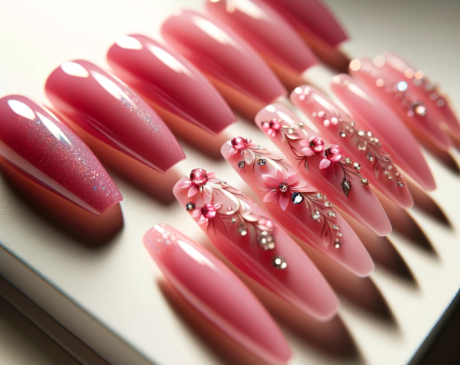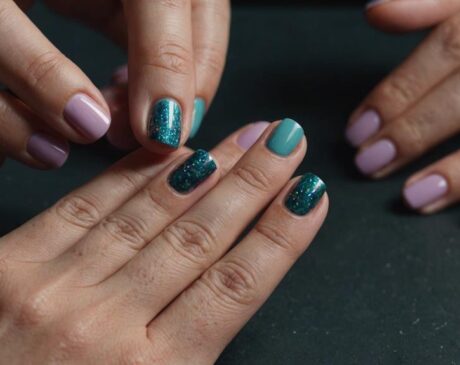How do you get press-on nails off without acetone?

Acetone is commonly used as a nail polish remover, effectively dissolving nail glue and removing artificial nails. However, it is not without its drawbacks. Acetone can cause skin irritation, leading to dryness and irritation. This is especially problematic for people with sensitive skin or nails. Additionally, frequent use of acetone can weaken natural nails, making them more prone to breaking and peeling. For these reasons, it may be beneficial to explore acetone-free methods of removing pressure nails to keep nails healthy and comfortable.
Acetone-free Method of Removing Press-On Nails
Warm Water Oil Method
This method is gentle and effective, utilizing common household products.
Step-by-step guide
- Prepare the solution: Fill a bowl with warm water and add a few drops of a mild oil, such as baby oil or olive oil.
- Soak nails: Submerge your hands in the solution for about 15-20 minutes. The warmth and oil will help loosen the glue.
- Gently wiggle your nails: After soaking, try gently wiggling your nails. If it feels loose, carefully remove it.
- Clean & moisturize: After removal, wash hands and apply moisturizer to replace lost moisture.
Pros and Cons
Pros:
- Gentle on skin and nails.
- Uses readily available, non-toxic ingredients.
Disadvantages:
- Can be time-consuming.
- May not work well with very strong adhesives.
Flossing Technique
This method involves using dental floss to gently pry the nail open.
Step-by-step guide
- Prepare the floss: Take a piece of floss. Floss picks can also be used for ease of handling.
- Create an opening: Gently lift the edge of the nail using a wooden stick or your own fingernail.
- Slide and saw: Insert the floss under the lifted edge and use a sawing motion to break the adhesive bond. Work slowly to minimize damage.
- Clean: Once removed, clean nails and apply moisturizer.
Pros and Cons
Pros:
- Fast and effective.
- Provides more control over the removal process.
Disadvantages:
- Requires a bit of flexibility and can be challenging for beginners.
- May damage natural nails if overworked.
Use Soap and Water
A gentle, moisturizing method that’s perfect for sensitive skin.
Step-by-Step Guide
- Prepare soapy water: Mix warm water with mild soap in a bowl.
- Soak fingertips: Immerse fingertips in the solution for approximately 15-20 minutes.
- Gently Peel Nails: After soaking, gently peel nails starting at the edges. If necessary, use a wooden stick for assistance.
- Aftercare: Rinse hands and apply hand cream or nail polish.
Pros and Cons
Pros:
- Very gentle and ideal for sensitive skin.
- Moisturizes skin and nails during the process.
Disadvantages:
- May not be effective on stronger glues.
- Requires patience and gentle handling to avoid damage.
Precautions and Tips
Nail Care After Removal
After safely removing press-on nails, it is vital to take gentle care of your natural nails. Here are some steps to follow:
- Moisturize your nails: Apply a nourishing nail polish or cream to restore moisture. This helps combat any dryness caused by adhesives or the removal process.
- Gently buff the surface: If there is any adhesive residue, gently buff your nails with a soft nail polish. Avoid applying too much pressure as this may cause damage.
- Keep nails trimmed: Shorter nails are less likely to get hooked and break. Keep them neatly trimmed and filed.
- Give your nails a break: Give your nails a break before performing another set of press-ons or any other type of nail enhancement.
- Eat foods that are good for your nails: Include in your diet vitamins and minerals that promote healthy nails, such as biotin, vitamin E, and omega-3 fatty acids.
Common Mistakes to Avoid
To keep your nails healthy, avoid the following common mistakes:
- Prying your nails open: Never pull or pry your pressed-in nails open as this can damage your natural nail bed.
- Neglecting to moisturize: Neglecting to moisturize your nails after removal can lead to dry, brittle nails.
- Over-polishing your nails: Over-polishing can thin your nails and make them weaker.
- Reapplying immediately: Applying a new set of press-on nails immediately after removal can put pressure on your natural nails.
- Ignore signs of damage: If you notice any signs of damage or infection, it’s best to consult a professional.
Alternatives to Acetone
Acetone-Free Remover Listings
There are several acetone-free nail polish removers available that are gentler on nails and skin. They usually contain less harsh solvents such as ethyl acetate or isopropyl alcohol. Popular options include:
- Soy removers: These removers use methyl soyate derived from soybean oil, known for its moisturizing properties.
- Ethyl acetate removers: Many “natural” nail polish removers contain ethyl acetate, which is less aggressive than acetone.
- Conditioning removers: These removers often contain added oils and vitamins to help condition the nails and cuticles.
Natural Home Remedies
If you prefer a completely natural approach, consider the following home remedies:
- Lemon juice and vinegar mix: The acidity of lemon juice and vinegar can help dissolve nail glue.
- Alcohol-based products: You can use topical alcohol or hand sanitizer in small amounts to weaken the adhesive.
- Warm water soaks: Regular warm water soaks can gradually loosen the glue, especially when mixed with oil.
Comparison Table: Acetone vs. Non-Acetone Methods
Comparison Factors
When choosing between acetone and non-acetone methods, consider the following factors:
- Effectiveness: Acetone is usually more effective and removes nail glue faster. Non-acetone methods may require more time or multiple attempts.
- Safety: Non-acetone methods are usually safer for skin and nails, especially for those with sensitivities or allergies.
- Time-consuming: Acetone removes nails quickly, while non-acetone methods, such as soaking in warm water or using oil, take longer.
Removing press-on nails without acetone is not only possible but also recommended for those looking for a gentler method. We explored a variety of methods such as the warm water and oil technique, the flossing method, and the use of soap and water. Each of these methods offers a safer alternative to acetone, reducing the risk of drying or damaging nails and skin.
While these methods may require more time and patience than using acetone, they are beneficial in maintaining the health and integrity of natural nails. Proper nail care, such as moisturizing your nails and avoiding over-polishing, must be performed after removal to ensure they remain strong and healthy.
Final Advice
For those looking for a safe and effective way to remove press-on nails, consider trying these non-acetone methods. Remember to be gentle during the removal process and to take adequate care of your nails afterward. If you experience any difficulties or notice signs of damage, consult a professional. Choosing the right method depends on your personal preference, the condition of your nails, and the strength of the adhesive used.
Frequently Asked Questions
Is it safe to use warm water and oil to remove press-on nails?
Yes, it is safe. This method is gentle and moisturizing to the nails and skin. The warm water dissolves the adhesive, and the oil moisturizes the nail, making it an ideal combination for nail removal.
How long does it take to remove press-on nails using the non-acetone method?
Time can vary depending on the method used and the strength of the adhesive. Typically, it may take 15 to 30 minutes. For example, the warm water and oil method may require about 20 minutes of soaking.
Can I reuse the compression nails after removing them without using acetone?
Yes, in many cases, you can reuse press-on nails if they are removed carefully and gently. Make sure they are cleaned and stored properly after removal.
What are the best natural remedies for post-removal nail care?
After removal, it is beneficial to apply nourishing oils such as jojoba oil, almond oil, or vitamin E oil. Regularly moisturizing your hands and nails and eating a diet rich in vitamins and minerals will also help keep your nails healthy.
Are there any risks associated with flossing techniques?
The main risk of the flossing technique is that it can cause damage to your natural nails if too much force is applied. It is important to be gentle and patient when using this method to minimize the risk of nail injury.




